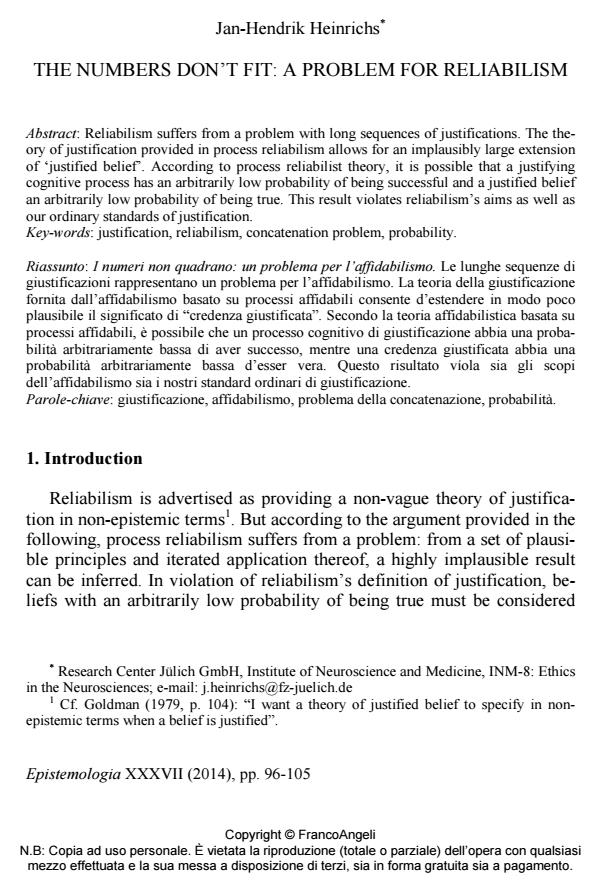The numbers don’t fit: a problem for reliabilism
Titolo Rivista EPISTEMOLOGIA
Autori/Curatori Jan-Hendrik Heinrichs
Anno di pubblicazione 2014 Fascicolo 2014/1 Lingua Italiano
Numero pagine 10 P. 96-105 Dimensione file 579 KB
DOI 10.3280/EPIS2014-001006
Il DOI è il codice a barre della proprietà intellettuale: per saperne di più
clicca qui
Qui sotto puoi vedere in anteprima la prima pagina di questo articolo.
Se questo articolo ti interessa, lo puoi acquistare (e scaricare in formato pdf) seguendo le facili indicazioni per acquistare il download credit. Acquista Download Credits per scaricare questo Articolo in formato PDF

FrancoAngeli è membro della Publishers International Linking Association, Inc (PILA)associazione indipendente e non profit per facilitare (attraverso i servizi tecnologici implementati da CrossRef.org) l’accesso degli studiosi ai contenuti digitali nelle pubblicazioni professionali e scientifiche
Reliabilism suffers from a problem with long sequences of justifications. The theory of justification provided in process reliabilism allows for an implausibly large extension of ‘justified belief’. According to process reliabilist theory, it is possible that a justifying cognitive process has an arbitrarily low probability of being successful and a justified belief an arbitrarily low probability of being true. This result violates reliabilism’s aims as well as our ordinary standards of justification.;
Keywords:Justification, reliabilism, concatenation problem, probability.
- Chi M.T.H., Klahr D. (1975). Span and Rate of Apprehension in Children and Adults, Journal of Experimental Child Psychology, 19(3), pp. 434-439.
- Comesana J. (2009). What lottery problem for reliabilism?, Pacific Philosophical Quarterly, 90(1), pp. 1-20.
- Goldman A.I. (1979). What Is Justified Belief?. In Goldman A.I., Liaisons: Philosophy Meets the Cognitive and Social Sciences, Cambridge (Mass.), MIT Press, pp. 105-126.
- Kaufman E.L., Lord M.W., Reese T.W., Volkmann J. (1949). The discrimination of visual number, American Journal of Psychology, 62(4), pp. 498-525.
- Leplin J. (2009). A Theory of Epistemic Justification, Dordrecht, Springer.
- Reys R.E., Rybolt J.F., Bestgen B.J., Wyatt J.W. (1982). Processes Used by Good Computational Estimators, Journal for Research in Mathematics Education, 13(3), pp. 183-201.
- Trick L.M. (2008). More than superstition: Differential effects of featural heterogeneity and change on subitizing and counting, Perception & Psychophysics, 70(5), pp. 743-760. Tversky A., Kahneman D. (1974). Judgment under Uncertainty: Heuristics and Biases, Science, New Series, 185(4157), pp. 1124-1131.
- Vetter P., Butterworth B., Bahrami B. (2008). Modulating Attentional Load Affects Numerosity Estimation: Evidence against a Pre-Attentive Subitizing Mechanism, PLoS ONE, 3(9), p. e3269.
- Wallis C. (1994). Truth-ratios, process, task, and knowledge, Synthese, 98(2), pp. 243-269.
Jan-Hendrik Heinrichs, The numbers don’t fit: a problem for reliabilism in "EPISTEMOLOGIA" 1/2014, pp 96-105, DOI: 10.3280/EPIS2014-001006